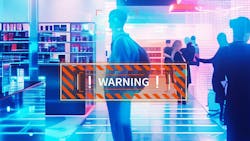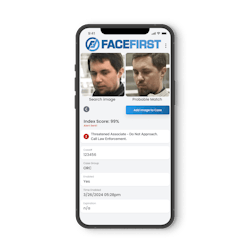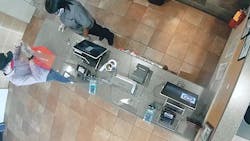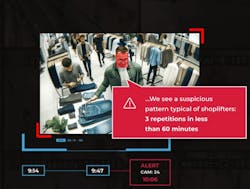This article originally appeared as the cover story in the August 2024 issue of Security Business magazine. Don’t forget to mention Security Business magazine on LinkedIn and @SecBusinessMag on Twitter if you share it.
The road hasn’t been easy for retailers the last few years between the COVID pandemic, competition from online shopping, and skyrocketing rates of retail theft and leakage at brick-and-mortar stores.
Businesses are reporting record levels of losses from shopper and employee theft. In some urban areas, flash mobs have descended on retail establishments and executed smash-and-grabs with frightening precision.
Organized retail crime (ORC) has become a multi-billion-dollar blight on retailers, and it is only spreading. According to the National Retail Federation’s (NRF) annual National Retail Security Survey, instances of organized retail theft saw the average shrink rate increase from 1.4% to 1.6% in 2022, a percentage increase that represents $112.1 billion in losses.
NRF is advocating for the passage of the Combating Organized Retail Crime Act (CORCA), a U.S. Congressional bill that would increase federal coordination with state and local law enforcement to fight retail crime.
Security integrators who understand a retail client’s challenges and who partner with the right vendors to offer efficient and effective solutions can develop a new or enhanced customer base and revenue stream.
Technology Expansion…and Contraction
This rise in shoplifting obviously poses some unique opportunities for integrators willing to think outside the box when it comes to retail security.
Lowe’s has launched Project Unlock, which “uses low-cost RFID chips and scanners, and a novel use of blockchain, to tackle the theft of powered products in a way that is virtually invisible to our customers,” according to a video posted by the company in 2023.
The solution is powered by “digital point of sale activation” – where only products that are legitimately purchased are activated upon purchase. This is achieved through low-cost battery-free RFID tags during the sales process. “Our customer never has to think about it,” Lowe’s says. “When a thief steals the product and tries to resell it, it won't work.”
Technology is also expanding into the parking areas in some locales. Dick’s Sporting Goods has taken advantage of a growing trend in the security industry by deploying mobile surveillance units – in this case, from surveillance provider LiveView Technologies – in parking lots of some stores to discourage retail crime and work more closely with local law enforcement.
Of course, artificial intelligence technology is also being brought to bear on the loss prevention problem. During the NRF Protect show – the country’s largest gathering of loss prevention pros – in Long Beach, Calif., this June, NRF’s Nkongho Beteck wrote about AI technology featured at the show that can decode the intentions of individuals.
“FaceFirst’s ‘ethical face matching platform’ tool combines human decision-making and assisted AI that could identify a previous shoplifter who is known to have violent tendencies,” FaceFirst President and COO Dara Riordan said during a session at the show.
On the other hand, a rash of theft at self-serve checkout lanes has led to a paring back of the technology in favor of human cashiers. According to media reports, Walmart has removed the lanes from several stores, and Dollar General announced it was removing self-checkouts entirely from 300 stores while converting thousands to manned checkouts or limiting customers to five items. Target and Costco have also taken steps to limit the amount of items or increase human staff in self-checkout lanes.
In California, a new bill still being discussed and amended by lawmakers prohibits grocery and drug stores from operating self-checkout stations if they have inadequate staffing.
Case in Point: Quick-Service Restaurants
Dairy Queen and video surveillance provider March Networks have announced a technology partnership integrating video with the restaurant’s Point-of-Sale (POS) system – correlating high-definition surveillance video with transactions. The integration is poised to reduce loss from theft, improve operations, and increase speed-of-service; thus, increasing profitability.
“The goal is to provide a security and loss prevention system that will speed up investigations, automate operations audits, and deliver real-time notifications of critical events,” explains Net Payne, Chief Sales and Marketing Officer at March Networks. “Stores now have a chance to turn video from a reactive tool to a proactive one, using AI analytics to identify people or vehicles in advance that are the repeat offenders.”
Franchisees will have remote access to any surveillance device from any location at any time through desktop, web, or mobile, and real-time alerts for suspicious transactions and security threats.
The company says security challenges for quick-serve restaurants (QSRs) are very real: they lose up to 7% of revenue due to employee theft, employee theft accounts for 75% of restaurant industry losses, and 75% of employees have admitted to stealing from the workplace at least once.
Payne notes that the industry shift to cloud-based solutions is making it easier to scale tech solutions for smaller customers, such as QSRs.
“Technology has changed enough that you can use the cloud as a way to help smaller [customers] manage their video infrastructure without needing an IT staff,” Payne says.
Analytics on a Larger Scale: Malls and Mega-Retailers
Malls and retail chains are also seeing the benefits of facial recognition and video analytics for enhanced security, some of them showcased recently at NRF Protect.
“The most common reason why malls and retail chains use facial recognition capabilities is watchlist alerting,” explains Gabriel Lerner, CEO of ISEG Corp., a provider of security technology and guard services in Latin America. “When an individual on the watchlist is detected by the facial intelligence platform connected to the security cameras, the security team receives a real-time alert.”
In February, ISEG announced a technology partnership with Corsight AI, which specializes in “Facial Intelligence” technology. A key aspect of the technology is the watchlist function that Lerner describes.
Lerner explains that the system can also identify specific predefined scenarios typical of shoplifters, even if the individual involved is not known beforehand – such as returning to the same store with high frequency in a short time, two suspects cooperating, the interaction of one of the suspects with staff, and other appearance patterns that indicate a high probability of a crime about to occur.
The technology is also being used to protect restricted areas. While the sales floor of stores is open to everyone, areas such as the warehouse, the back office, or the control room contain expensive goods and sensitive information and must be secured from unauthorized parties. “These areas are protected using facial recognition-based access control, which is more convenient and secure than keys or fobs,” Lerner says.
Finally, the security of these large facilities during closing hours and protection against burglary is another common use-case. When the same person is identified outside the store or warehouse with suspicious frequency or beyond the predefined period, the security teams trigger an alert that allows them to examine the security cameras in real-time.
Emerging Solution: Foggers
One solution gaining traction is devices that spray a disorienting fog to discourage or prevent theft of property. Israel-based Essence Security has sold more than 1 million of the devices in Europe and has been working to bring this technology to the U.S.
“AI and facial recognition systems work, but at the end of the day, they don't save property and people, because it all comes down to how quickly the police come,” explains Essence VP Stephen Burd, who notes that typical response times by police to a retail crime can be anywhere from 5 to 60 minutes.
The MyShield fogger from Essence covers about 5,000 square feet and fills a typical storefront in about 30 seconds. They can also be daisy-chained together to protect more square footage, such as a warehouse or distribution center. They include automated voice alerts and video verification so fog can be distributed for true threats vs. false ones.
Editor’s Note: Read more about security foggers in Paul Benne’s Tech Trends column that appeared in the July issue of Security Business: www.securityinfowatch.com/55092100.
Burd says that in more than 90% of the cases, criminals who encounter the fog are forced to vacate the premises. “You can't see, you can't steal, you can't shoot,” he says, adding that the unit can be activated via a central monitoring center or in-store panic buttons.
Anticipating the Next Threat
With so many established and emerging technology options, integrators are poised to be the go-to resource for retail security executives. That also means looking at future threats.
In a keynote address by Nikolas Badminton of futurist.com at NRF Protect, Beteck wrote that he recommends retailers (and by extension, the integrators serving them) to “enter an era of anticipation, scanning for signals of change to keep their eyes on emerging threats around the corner.”
That said, for now it remains prudent for integrators to advise and actively help retailers choose defenses against an ORC problem that is clearly not fading away.
“Despite recent press articles that look to downplay ORC or argue about data, it is abundantly clear from retailers’ experience with ORC that the criminal activities we witness in stores across the nation and the incidents of violence tied to them are on the rise,” David Johnston, the NRF's VP of Asset Protection and Retail Operations, said during a December 2023 statement to the House Subcommittee on Counterterrorism, Law Enforcement, and Intelligence. “We continue to believe that ORC is a 'gateway crime' and investigations have shown the profits from these crimes are often linked to far more nefarious crimes. What we have come to understand about ORC is that theft in our stores is merely the tip of the iceberg.”
New York OKs Tax Credits for Security Tech
All retail small businesses in the state are eligible
By Jake Parker and George Sewell of the Security Industry Association (SIA)
In late April, the New York State legislature passed its annual budget measure for fiscal year 2025, which addresses multiple priorities and enacts key proposals from Gov. Kathy Hochul. Of significance to New York business owners, workers, and consumers, the measure includes a new Retail Security Tax Credit, which for tax years 2024 and 2025 will provide assistance to businesses for investing in equipment to protect their employees and merchandise.
Each year, New York retailers lose roughly $4.4 billion a year due to various kinds of theft. The budget agreement includes the new tax credit among Gov. Hochul’s 5-point policy plan aimed at fighting organized retail theft, which includes:
- Increasing criminal penalties for any individual who attacks a retail worker from a misdemeanor to a Class E felony.
- Allowing prosecutors to combine the value of all stolen goods from different stores when charges are brought against the criminal.
- $40.2 million to support retail theft teams at state police, district attorneys’ offices and local law enforcement agencies, including the addition of 100 New York State Police personnel who specifically focus on retail crimes.
- A total of $5 million in tax credits for businesses in each of the calendar years 2024 and 2025 to invest in extra security measures, for businesses that spend the threshold amount on their retail theft prevention measures (see below).
To be eligible for this tax credit, a business must:
- Have 25 or fewer total employees and must operate one or more physical retail locations that are open to the public.
- File a tax return pursuant to articles 9, 9-A or 33 of the tax law.
- Must have qualified retail theft prevention measure expenses that exceed $3,000 for each New York retail location during each taxable year.
- Provide certification in a manner that is described by the commissioner that the business participates in a community antitheft partnership as established by the division between local business and law enforcement agencies.
- Not owe past due local, state or property taxes unless there is a prior, agreed-upon and binding payment agreement.
Commercial businesses may apply for this credit as long as they meet the criteria listed above.
“Qualified retail theft prevention measure expenses” refers to any combination of costs related to retail theft prevention measures that are paid or incurred by a qualifying business that exceeds $3,000 per New York retail location.
There is a cap on the amount of credits a business can claim, up to $5 million per calendar year. Retail theft prevention measures include security officers, cameras, perimeter security lighting (interior and exterior), locking or hardening mechanisms, alarm systems, and access control systems.
To get approved for the credit, a business owner must submit a completed application yearly as prescribed by the commissioner by Oct. 31 of each year.
About the Author
John Dobberstein
Managing Editor/SecurityInfoWatch.com
John Dobberstein is managing editor of SecurityInfoWatch.com and oversees all content creation for the website. Dobberstein continues a 34-year decorated journalism career that has included stops at a variety of newspapers and B2B magazines. He most recently served as senior editor for the Endeavor Business Media magazine Utility Products.






